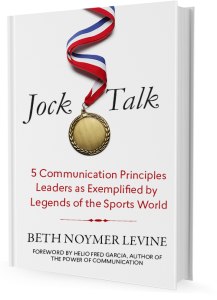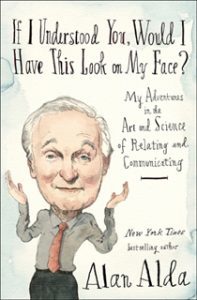SmartMouth Talks!
Stop Talking
Last week, I was strolling the streets of Manhattan, killing time, when I walked by one of those nice stationery stores that sells not only paper, but beautiful cards, planners, and novelty items. I was thinking it was almost time for a 2019 calendar (yes, I still love a paper calendar!) and so I went in to browse.
 The first thing I spotted, on a display table that sat front-and-center, was a stack of small black boxes that said “Stop Talking” on the front. I couldn’t imagine what they were. Luckily, one of the boxes was already opened and so I got a look – inside were 50 or so ivory-colored cards that also said “Stop Talking” in black ink.
The first thing I spotted, on a display table that sat front-and-center, was a stack of small black boxes that said “Stop Talking” on the front. I couldn’t imagine what they were. Luckily, one of the boxes was already opened and so I got a look – inside were 50 or so ivory-colored cards that also said “Stop Talking” in black ink.
This is when my head-scratching began. So, for $9.95, I could have 50 of these little cards to hand out to over-talkers? When would I use these and how? Were these for chatty friends who, over coffee, start answering ‘what’s new?’ and then never come up for air? Were these for those meeting participants who talk for the sake of hearing themselves talk? Were these meant to be surreptitiously slipped onto the desks of neighboring cubicle dwellers who talk too much and too loudly?
My imagination ran wild. And then it stopped. I decided these little “Stop Talking” cards were for any and all of the above … and probably more. We live in a world of talkers, and clearly someone invented this novelty item on the theory that there would be plenty of consumers who would find these “calling cards” amusing and/or useful.
What does this say, then, about how we’re doing with two-way communication? Can you imagine a similar offering of 50 “Stop Listening” cards? I can’t. The problem is that the talking side of the communication see-saw is always over-weighted, and the listening side is under-weighted. Anecdotally, I know this to be the case because I often get asked if I can coach people to be more succinct and to listen better, sometimes teams of people. It’s quite common that people talk more than others can bear, and it’s universally challenging among individuals and groups alike.
For those who are nodding in agreement while reading so far, here are 5 quick-tip reminders about listening versus talking that you can use as refreshers for yourself or that you can share with your favorite over-talker(s):
- Think about your audience: Is this someone/a group you should be listening to more (boss or client) or talking to more? Is there really anyone you should be talking to more than you should be listening to? Balance your talking with listening.
- Train your brain to go into neutral and simply be present and listen. Literally, stop your brain for a minute. Focus. Hear. Process. Listen, stop talking.
- Listen for the purpose of empathizing and relating rather than listening for the purpose of formulating a response. You might not need to formulate a unique response at all, you might just need to reiterate/reinforce/validate what you heard. Slow down. Listen, stop talking.
- Listen for the purpose of learning, gaining insight or gathering intelligence. Listening can produce some very valuable material you can use to your advantage later on. If you’re talking, you’re not learning. Listen, stop talking.
- Listen intently, actively and sincerely. Be that person. So that when you want to talk and be influential, you will surely be given your due. Listen for real, so you when you need to talk, others will listen.
Those “Stop Talking” cards stopped me dead in my tracks and got me thinking. I’m not sure I’d have the gumption to hand them out, but I considered it. More than that, they prompted me to think about communication as a two-way transaction that breaks down when one way gets more traction and time than the other. The fix is simple, though: stop talking so much, start listening more!
5 Principles for Elite Communicators
It doesn’t take much to be a good leader-communicator. Perfection may be elusive, but being good enough to earn the admiration of your team are well within reach. Adherence to a few core principles takes care of most situations.
 In my book Jock Talk: 5 Communication Principles for Leaders as Exemplified by Legends of the Sports World, I walk readers through the philosophy behind, and application of, these 5 principles: Audience-centricity, Transparency, Graciousness, Brevity, and Preparedness.
In my book Jock Talk: 5 Communication Principles for Leaders as Exemplified by Legends of the Sports World, I walk readers through the philosophy behind, and application of, these 5 principles: Audience-centricity, Transparency, Graciousness, Brevity, and Preparedness.
1 Turn at the Podium, 3 Speeches
“There are always three speeches, for every one you actually gave.
The one you practiced, the one you gave, and the one you wish you gave.”
Dale Carnegie
 This is a daunting thought for overachievers or anyone who strives to do their best at the front of the room!
This is a daunting thought for overachievers or anyone who strives to do their best at the front of the room!
Or not? You might be one of those people who is so relieved to be done with your talk and still have a pulse that you don’t bother to reflect on any of the three, and especially not on the speech you wish you gave.
But you should.
That third one – the speech you wish you gave – is the one that’s most valuable. To you. Your audience is likely fine. The one you gave is the one you practiced, augmented by shots of adrenaline and the energy (or lack thereof) in the room.
It’s the one you wish you gave, though, that is loaded with wisdom for your next turn at the podium. Don’t let 24 hours pass before you give it some thought and, instead of sighing and saying oh well, make some ‘notes to self’:
On Content
Did I open well and grab their attention right away? Would I open differently the next time?
Was every section relevant?
What about the length? Too long/too short?
Did I stray into too much detail in one section while the other sections were more succinct?
Did their questions reveal an interest that was different from the angle I prepared?
What did I wish I had included/excluded?
What are three things I could do to make this content more memorable?
On Delivery
Did I move around and use the floor, or did I stand in one place the whole time?
Did I look at my slides too much (or worse, read them)?
Did my voice have energy, convey passion or dedication to the material?
What about my eye contact in the room? Is that something I could have done better?
Was I able to move forward, toward the audience, giving them the sense that I wanted to be there?
Did I talk too fast? Should I have incorporated some pauses where the audience needed to digest the material?
Making ‘notes to self’ immediately after a talk is one of the simplest ways to help yourself improve as a speaker. Not only are you your own harshest critic, but because you are the source of your own feedback, you’ll understand it completely and you’ll be more motivated to correct it the next time around. The only tricky part is remembering to refer to your notes before you prepare to speak again.
Rocket Science … Not
 Communicating effectively is not rocket science (maybe this is why rocket scientists are not known to be great communicators?). It’s rarely considered something that’s terribly complicated or difficult, yet I have spent the better part of a decade and a half “dumbing it down” so that professionals of all types can be more clear, more concise, and more successful at getting their points across to other busy (read: busy-minded) people.
Communicating effectively is not rocket science (maybe this is why rocket scientists are not known to be great communicators?). It’s rarely considered something that’s terribly complicated or difficult, yet I have spent the better part of a decade and a half “dumbing it down” so that professionals of all types can be more clear, more concise, and more successful at getting their points across to other busy (read: busy-minded) people.
The reality is, I’m not actually making it dumber, I’m making it simpler. Less work. Less time. Easier for the speaker (to remember, deliver). Easier for the audience (to pay attention, retain). And the simpler I make it, the more accessible it is to everyone regardless of their level in an organization, and therefore the more widely utilized it is.
On more than a few occasions in the past few months, when I’ve been invited to share my simple framework for communicating effectively, the CEO has been in the room with his or her team for the session. My approach and the SmartMouth methodology have been met with sighs of relief and exclamations of “this is what I have been trying to tell all of you!” In one case, I was met with what could only be described as excitement and joy – clearly, this executive has spent a good bit of time being frustrated with his team’s communication skills.
Since there are a lot of rocket scientists out there – i.e. a lot of smart people with a lot of dense technical knowledge in a variety of fields – I want to share my top 3 pieces of advice for any communicator. You could be a keynote speaker or you could be a participant in a meeting. It doesn’t matter. These 3 are game changers.
1. TMI is the #1 killer.
If I could fix only one thing about how people speak or present, I would attack the “too-much-information syndrome.” In fact, I do attack it, and pretty regularly. Here are some root causes of the problem, see if they sound familiar: presenters who feel the need to prove how smart they are, presenters who love their detail because it fascinates them, presenters who don’t (or can’t?) prioritize their brain dumps, thereby leaving it to their audiences to figure out what’s important.
Information is only valuable and, arguably, relevant when it supports a point. So identify your point first and then pick the information that best supports it (a point is a statement that captures significance or value as a main thought or idea does, or one that summarizes a collection of information). The amount and type of information a speaker chooses to use should be based on the audience – their appetite, their needs/interests, their level of sophistication – not based on what floats the speaker’s boat. If you are sitting with a pile of information that you need to present, ask yourself how you might capture the importance or benefit of all that detail in once sentence and deliver that first, followed by the info.
Finally, less is more. If you can eliminate some information, even better!
2. Serve dessert first.
Life is short, and so are attention spans. Serve dessert, or the point, first. Everything else, like information, is a side dish. Audiences don’t have endless attention to give you, and there are lots of distractions in any given room (some, like devices, give instant gratification when you don’t!). Audiences need a reason, and some context, to hang in there with you.
You can serve dessert first in two ways: First, think about telling your audience upfront what you want them to think, know, do or feel by the end of your talk. And when I say upfront, I mean it’s okay to make this one of your first few sentences – while audience attention is still fresh and on you. You literally can spoon-feed them the impression you hope they’ll take away or the action you hope they’ll take when they leave the room. Second, per the above section on TMI, don’t deliver a truckload of information and then serve up the conclusion; instead, figure out what your conclusion or point is, deliver that first, and then unload your information.
Dessert first!
3. It’s not all about you, it’s about them.
Have empathy! For your audience, that is. Consider the experience you are about to give an audience based on your own experiences. You know what it’s like to sit through a presentation or a talk. You know how often you check out, what you like/don’t like when someone else is at the front of the room, or what visuals you find helpful or enjoyable. Use your own experiences to inform the kind of experience you want to give your audience(s).
No matter how much you love your topic, or no matter how urgent it is that you share your content, think about them – who they are, what they really care about, where they are on the learning curve of your topic, why they’re in the room, and how you might impress them – and then adjust your content accordingly. Their needs and interests are more important than yours. I always say, there’s an unspoken agreement between speaker and audience that, in exchange for their time and attention, you will give them something useful or valuable – which you can determine based on the who, what, where, why and how listed above.
Putting these 3 pieces of advice into practice may take some time, but even just the awareness will help you make some advances in your communication skills and style.
Supersize to Emphasize
It’s funny when people ask what they should do to emphasize something in their speech or presentation. Seems like, depending on what it is they want to emphasize, they would know best. After all, it’s part of their content, it means something special to them, and it’s their goal or intention to call it out.
 Even though I’m sometimes tempted to snark back, “well, how would YOU LIKE to emphasize it,” I usually offer a menu of options. Not surprisingly, the menu items all have a common ingredient: supersizing. Go big or go home. Whatever they choose to use, it’s got to be bigger, more, louder, better, stronger, or different.
Even though I’m sometimes tempted to snark back, “well, how would YOU LIKE to emphasize it,” I usually offer a menu of options. Not surprisingly, the menu items all have a common ingredient: supersizing. Go big or go home. Whatever they choose to use, it’s got to be bigger, more, louder, better, stronger, or different.
Here are four supersizing options for you to consider using the next time you really want the room to hear it, get it, remember it:
Words. Choose special or unexpected words. Use a killer metaphor. Construct an especially brief sentence. Repeat the words. Repeat the words again. Make a rhyme. Use call and response with your audience.
Energy. Change the energy in your voice or your body. Get louder for a few seconds. Animate with your hands. Move across the floor or stage. Stop and stand still if you’ve been moving. Get on your toes. Move as close to the audience as you can. Throw some theatrics in (note: what feels “theatrical” to you will simply seem “energetic” to the audience).
Pauses. Create a few seconds of anticipation prior to what you want to emphasize. Leave a few seconds for marination following what you want to emphasize. Give your pause a drumroll – for example, “I’m going to pause here because what I have to say next is critical …”. Take a measured pause in. between. each. word. of. the. sentence. you are emphasizing.
Labels. Slap labels on your emphasized content. For example, “If there’s one thing I want you to remember,” “I cannot emphasize enough,” “This cannot be overstated.” Labels warn and wake. They guide and grab.
Help your audience out. Even the best of the best – those audience members who are paying attention – may not catch something you’re trying to emphasize unless you supersize it somehow. Audiences don’t know what you want them to know or remember unless you tell them!
Meetings Checklist: 4 Questions to Avoid Wasting Time
 Meetings are pure communication opportunities – people speak, people listen, people discuss, people ask and people answer. If you’re not going to be contributing to or benefiting from one of those communication opportunities, then maybe the meeting is not for you.
Meetings are pure communication opportunities – people speak, people listen, people discuss, people ask and people answer. If you’re not going to be contributing to or benefiting from one of those communication opportunities, then maybe the meeting is not for you.
Calling or attending a meeting should be decided on whether or how well it will enhance organizational effectiveness and individual or collective productivity. At best, good meetings represent only half of all meetings. And even if it’s a “good” meeting, 91% of meeting attendees across the country say they daydream and 73% do other work.
With those data in mind, one can hardly make a case for maintaining the status quo. So let’s think about “coloring outside the lines” of one of the most enduring old-school communication practices in the business world and ask ourselves these basic questions before calling or attending a meeting:
If I’m the meeting leader …
- Am I holding the meeting because it’s our regular time and not because we actually have a need to meet? If that’s the case, can I cut it super short – maybe only 5 minutes of “good and welfare” or a “share” of some kind – and then let people get back to their work?
- Am I prepared with the meeting’s purpose, agenda, time limits and relevant participants? If not, should I reschedule and redefine the parameters rather than winging it and potentially wasting the time of a lot other busy people?
If I’m an attendee …
- Do I actually need to attend this meeting? In other words, will it be helpful/meaningful if I can contribute something or will it be helpful/meaningful if I can learn something? Can I decline to attend without repercussion?
- Once there and realizing it’s not a relevant meeting for me, do I need to stay? Do I stay simply to avoid appearing impolite? Or can I duck out, get work done, and explain/excuse myself later?
The meeting is a behemoth left over from the 20th century business culture. While we’ve changed so much about how we work and collaborate in the 21st century, it’s kind of amazing that meeting protocols have not changed very much at all. We gather in groups and measure the communication in quantity, not quality.
Not surprisingly, companies like Amazon are bucking the status quo and giving us some great ideas and examples for improving meeting culture. So my challenge to you is this: if Jeff Bezos can color outside the lines – in the interest of effectiveness and productivity – then maybe you should too!
3 Reasons to Care About Communications
 Communication is the currency of success. No one succeeds alone; every single one of us needs to communicate in order to get things done, achieve goals, and succeed.
Communication is the currency of success. No one succeeds alone; every single one of us needs to communicate in order to get things done, achieve goals, and succeed.
Good communication skills are therefore critical to organizational effectiveness and personal success. Yet not enough organizations embrace excellence in communication as a value or a performance imperative.
This is my personal crusade. Excellence in communication doesn’t just happen, it needs to be cultivated and nurtured by organizations and the people who lead them.
While the direct ROI of excellence in communication may not be easily measurable, it would be hard to argue that strong communication skills don’t yield better results in selling, negotiating, client and customer service, employee relations, you name it.
Whether anecdotally or through research, I have become almost painfully aware that there are three elements that make a pretty compelling case for looking more closely at how communication impacts your organization:
1. Performance Issue. Over the past couple of years, I have heard from clients that communication skills consistently emerge as the #1 area of need in performance reviews. In fact, it’s become pretty standard for me, that whenever I meet an HR person, I now ask what tops their list of performance needs, and communications skills are always at or near the top.
2. Career Maker/Breaker. I’ve also observed that communication skills are seen as something that can make or break careers – even by organizations that don’t explicitly embrace good communication skills as a performance imperative.
Anecdotally, I’ve often been hired to coach high-level executives who are either long-winded, short-tempered or not inspiring enough. These are people in the C-Suite who might be flailing a little bit or need a boost; they may be technically competent but communication-challenged. Or I’ve worked with executives who have C-Suite potential but their ability to communicate clearly and influence with confidence is just not there yet.
Straight out of recent headlines, a University President just lost her job in large part due to her poor communication skills. Ironically, however, she is keeping her faculty post in – wait for it – the School of Communication Studies. Nonetheless, she was cited in her termination letter for failures to listen and to communicate well, whether written or oral.
There’s also research that shows how recruiters and employers view and value communication skills, which impacts people’s careers:
According to a 2014 survey of 565 global employers by the Graduate Management Admission Council (GMAC), which administers the business school entrance test, corporate recruiters ranked communication skills ahead of teamwork, technical knowledge and leadership when assessing MBA graduates for mid-level jobs. They rated communication skills ahead of managerial ability by a two-to-one margin.
Also in 2014, in an online survey of 845 North American business executives, respondents identified leadership and effective communication as the two most important management competencies – as well as the two most in need of improvement!
3. Complaint. Perhaps one of the most compelling reasons to care about communications lies in one of the biggest complaints in the business world – and one of the biggest impacts on organizational effectiveness – which is long, boring, tedious meetings and presentations.
It is estimated that there are 25 million meetings in the U.S. per day, 30 million PowerPoint presentations per day, and that more than $37 billion per year is spent on unproductive meetings. Yikes!
C-Suite executives are estimated to spend 85% of their time with other people – largely in meetings. Upper management spends 50% of their time in meetings. And middle management spends 35% of their time in meetings.
Why do I pick on meetings and presentations? Because they are the most common and most pure vehicles for business communication. They’re supposed to be productive, but our experiences tell us otherwise.
Communicating is not something people just do, like breathing. When performance and success are on the line, it needs to be thoughtful and deliberate. You exchange this valuable currency a lot, you communicate all the time, so embrace its importance and get it right. Your organization’s effectiveness and your success depend on it!
Cut to the Chase!
In a nutshell …
The bottom line is this …
In conclusion …
 Let’s face it, when you hear a speaker say one of these phrases, your ears perk up. Either the speaker is letting you know they’re about to share the CliffNotes version of their point, thereby bailing you out because your mind has been wandering. Or the speaker is sending the signal that they’re wrapping up their talk, and there’s no sweeter sound than that of an ending!
Let’s face it, when you hear a speaker say one of these phrases, your ears perk up. Either the speaker is letting you know they’re about to share the CliffNotes version of their point, thereby bailing you out because your mind has been wandering. Or the speaker is sending the signal that they’re wrapping up their talk, and there’s no sweeter sound than that of an ending!
I know you’re nodding in agreement. We all agree on this. Speeches and presentations can be tedious. The captivating ones are few and far between. We want it in a nutshell, we want the bottom line, we want the speaker to tell us what the conclusion is. And if this is what we want from them, then it is also what our audiences want from us. The Golden Rule applies; we should do unto others as we would want them to do unto us.
Why, then, is it so hard for business presenters to cut to the chase? Here are a few theories. Check yourself against this list:
Smarts/credibility. I need to share enough information to prove that I’m smart enough and good enough to be standing here or to have this job. Leave your self-doubts at the door. Prepare a talk that embodies confidence and command because it doesn’t hit on every detail. You have the job, don’t you? You’re at the front of the room, aren’t you? Show your smarts and earn your credibility by being crisp and concise.
Thoroughness/credibility. If I’m not thorough, they won’t understand. And if they don’t understand, they might think I don’t know what I’m talking about and/or they won’t be able to make the decision they need to make. Again, throw your negative self-talk in the dumpster outside the building before you enter. That’s the first step. Second, ask yourself if they really need to have the same level of understand as you do in order to get to a decision? Related to that, are you sure they won’t understand if you do a good job at bottom-lining it? The drive to be thorough is all about you. Make it about your audience and cut to the chase. If they don’t understand something and they need you to be more thorough, they’ll ask for it.
This is how we do it. I’ve seen my boss and my colleagues present before, and this is how they do it, they provide a lot of background. I’m just following their example. Oh boy, this is what perpetuates the mediocrity cycle. Keep a critical eye on your colleagues and superiors, they may not have the sharpest communication skills. Don’t be afraid to break the cycle for the sake of efficiency and effectiveness … and ultimately, success. Shape your communications based on your audience, not on self-perpetuating institutional tradition.
They told me I had 45 minutes. I’ve got a lot of time to fill, people are expecting a 45-minute presentation. Okay, so here’s where you go straight to the Golden Rule for guidance. Are you typically enraptured by 45 minutes of one person talking? Do you tend to remember what they said? Probably no and no. Consider preparing a more bottom-line oriented presentation and filling the 45 minutes by breaking up your talk with Q&A or discussion time throughout, or by finishing early. No one will be upset, I promise.
I need to explain first. I need my audience to know everything I know before I can share the conclusion. Unless you’re speaking in an educational setting – a classroom or a training – imparting everything you know on a topic is not necessary. Most business audiences are good with an appropriately superficial level of knowledge, knowing that if they need more comprehensive info you are there for them.
Some of the most popular formats for presentations demand cutting to the chase: TedTalks are quite informative yet are limited to 18 minutes. PechaKucha (20 slides, 20 seconds per slide) begins and ends within 7 minutes. These formats are popular because they are well-suited to adult humans with short attention spans and an ever-increasing amount of information available to them. And they’re enjoyable.
In short, be the solution and cut to the chase.
Best Laid Plans
It happens to me all the time.
 I prepare, prepare, prepare for what I’m going to say and do, whether I’m delivering a keynote or a training session. In fact, I only stop preparing when I get to the point where I’m convinced and pleased that I’ve thought of everything. Ha! While I probably have thought of everything I possibly could without being in the room, the best laid plans are just that – plans.
I prepare, prepare, prepare for what I’m going to say and do, whether I’m delivering a keynote or a training session. In fact, I only stop preparing when I get to the point where I’m convinced and pleased that I’ve thought of everything. Ha! While I probably have thought of everything I possibly could without being in the room, the best laid plans are just that – plans.
Invariably, frequently actually, I go “off script” in response to something in the room. It could be the audience (as it should be!) or it could be the room configuration, the presence or absence of a white board, or even something random about the environment. When I use PowerPoint, there might be something about the lighting or seating that prompts me to use my visuals a little differently.
Even if you aren’t neurotic about preparation like I am, you no doubt have your own best laid plans for presentations. But then there’s the room, the people, the day – there are a lot of variables and unknowns.
So what do you do when … ?
-
Your time allotment changes. This can be terribly unnerving to a presenter, especially to an apprehensive presenter who would rather not be there anyway and who definitely did not plan on doing improv or speed talking like an auctioneer.
Two suggestions here: 1) ask the event host or person who informed you about the time crunch what they would like you to cover or what about your presentation topic they feel is most relevant/valuable to the audience; and/or 2) let the audience know that, due to time, you’re delivering an abridged version of your presentation and, provided you know your main points well, deliver those with only limited supporting detail or choose your strongest main point and deliver that one in its entirety.
-
Technology fails. It may be 2018 and technology has given rise to some previously unimaginable things, like autonomous cars or cryptocurrencies, but in conference rooms and hotel ballrooms everywhere, simple technology still fails us. Projectors and laptops don’t synch, Internet connections get interrupted, video doesn’t play smoothly.
Recommendation: Don’t dwell on it. Move on. No one, and I mean not one person, in the audience wants to wait for or watch you try to fix it. You are responsible for your presentation, not your laptop. If your visuals aren’t working like you planned, skip over them. Describe them as if telling a story about the illustration you were going to show, and/or engage the audience in Q&A or dialogue sooner or more frequently during the presentation than you planned. Do your best in this situation but please avoid being so attached to the beautiful visuals you prepared that you forget about the connection between you and your audience.
-
There are far fewer/more people than you expected. I have had both of these situations, in their extremes. The “far fewer” scenario can leave you feeling crestfallen, deflated. The “far more” scenario can leave you feeling overwhelmed and daunted.
Bottom line: It’s all good. Don’t let this unexpected surprise throw you off. Each has a silver lining. A smaller than expected audience allows for more intimate interaction with your audience. A larger than expected audience is a potential opportunity to get your message out to more people. Both can be advantageous.
-
Your topic is clearly not what they were wanting or expecting. Yikes! You are speaking and you can tell you’re tanking. You keep on keeping on but you’re wondering why the heck you didn’t ask for an eject button or a hole in the floor where you could just drop down and disappear!?
I have three words of advice here: Switch. It. Up. Don’t be so driven to finish the presentation you prepared and planned that you abandon your audience. If you can tell you’re losing them or they’re not interested, ditch your presentation in favor of talking to/with your audience. Stop and ask them for questions or discussion. It will confirm whether or not they’re with you, and it will give way to a more lively and satisfying experience for all.
One caveat: If you switch it up and your audience has no questions or comments, you might need to prompt them. Ask them about their connection to the topic, their experiences, their expectations. It’s an imperfect situation for sure, but your audience is your go-to for the solution.
-
The room set-up is funky. Or the room assignment changes at the last minute. Either way, this presents a variable that’s way out of your control and possibly one of the most common. I can’t tell you how many times I’ve told a host I won’t be using a projector and it’s all set up, lights dimmed and all, when I get there. Or I ask for a large white board and it turns out they don’t have one, which I find out when I arrive. Or we’ve discussed having people sit at tables in a horseshoe shape, and the chairs are set up theater-style and there are no tables. I could go on and on.
Let’s keep this one simple. Be prepared for anything. Get there early. Size up the situation. Re-do your presentation “choreography” in your mind. Ask for what you need. And then just adapt.
Remaining adaptable is just part of the deal. There’s more out of your control than in your control when you’re presenting. So if there’s one final piece of advice I’d give, it’s this: Make “remaining adaptable” part of your mental preparation, it might well be your best laid plan.
Next Level Communication: Relating
Are you a communicator or a broadcaster?
Are you more inclined to participate in a dialogue or engage in a competing monologue?
Are you someone who listens to learn and appreciate or who listens to find a springboard to something you wanted to say?
The two-way street of communicating has many subtle nuances that – if I’m honest about this – are not sufficiently addressed in communication or presentation skills trainings. This is perhaps due to the many nuances or to their subtleties, which are highly individualized, depending on variations in people and situations, and therefore impossible to fully anticipate.
Nonetheless, in communication and presentation skills trainings, we tend to be more consumed with the command and impressiveness of the speaker than we are with the speaker’s ability to relate – to listen, appreciate, empathize and respond appropriately. We are focused on the performance side – the broadcasting, the competing monologue – more than the relating side. And when I say “we,” I’m talking about both trainer/coach and speaker. We both could do better.
 In Alan Alda’s book If I Understood You, Would I Have This Look on My Face?, he writes: “There’s a body of scientific literature on responsive listening, but I came to understand it in a personal way through my work. In acting, this kind of relating is fundamental. You don’t say your next line simply because it’s in the script. You say it because the other person has behaved in a way that makes you say it. Relating to them allows them to have an effect on you – to change you, in a way. And that’s why you respond the way you do.
In Alan Alda’s book If I Understood You, Would I Have This Look on My Face?, he writes: “There’s a body of scientific literature on responsive listening, but I came to understand it in a personal way through my work. In acting, this kind of relating is fundamental. You don’t say your next line simply because it’s in the script. You say it because the other person has behaved in a way that makes you say it. Relating to them allows them to have an effect on you – to change you, in a way. And that’s why you respond the way you do.
You don’t say your next line simply because it’s in the script. Wow. If you’re relating, then you need to remain open to ditching your proverbial script and to being affected, influenced even, by the other person’s words or point of view. This requires no anticipation and preparation; it merely requires being present, yielding, and genuinely leaning in and listening.
When I talk about “audience-centricity” in my trainings, it falls a little short of Alda’s responsive listening. I encourage speakers to prepare for meetings and presentations in a way that puts the audience’s needs, interests and experience ahead of their own. So yes, yielding to the audience and putting them first is important. It’s a start.
Then there’s also what I call “dynamic listening” – paying attention to your audience with all five senses. Watching, listening, sensing whether they’re with you, understanding you, energized or not. This is yet another step. But both of these – audience-centricity and dynamic listening – overlook the actual response side of the two-way street.
Relating, as Alda suggests, takes it to the finish line. It requires, as improv comedy does, that you open yourself to the words and reactions of others so that then, and only then, can you respond in a meaningful, relevant, relatable way.
The script is necessary; there’s no question you should always be prepared. But your next line, your response to a client or stakeholder, does not necessarily have to come from the script. It can come from the place of empathy and appreciation that you keep open in your eyes, ears, mind and heart.



